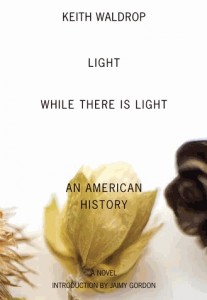Light While There Is Light: An American History by Keith Waldrop
 Light While There Is Light: An American History
Light While There Is Light: An American History
by Keith Waldrop
Dalkey Archive, 2013
220 pages / $14 Buy from Amazon or Dalkey Archive
“What I would like, I think, is to live a while longer. But not again.”
– Keith Waldrop
Light While There Is Light is called variously a fictional memoir, an autobiographical novel, and a masterpiece of twentieth century American fiction. I appreciate that the Dalkey Archive released it as Fiction. Somehow it feels better to call this a novel – and Waldrop seems to understand that. In reality I think that most readers assume a first person narrator should be equated with the author – what’s satisfying about this book is that it doesn’t seem to matter if you do or not. Despite the obvious allusions to the life of Keith Waldrop the person, and even the pictures that show Keith Waldrop the person in the text, this is a novel, not a memoir.
Compared to, say, Waldrop’s other work, this book is very accessible – readable even – and I’ve returned to it multiple times since receiving the book. I’ve enjoyed returning to it to go back and read a passage. It’s also illuminating (the book is full of light puns) to return and notice the kinds of motifs and themes that Waldrop uses throughout to create a kind of unified whole. It’s something that I would be happy to continue to read and reread, but also recommend that almost anyone read – It’s something that I’d recommend to friends, family members, writers, etc. There’s something to be learned from Waldrop’s sentences.
Despite what I would call a “straightforward” quality of the prose, every bit seems composed with intense attention to diction and pacing. It’s poetry, and it also bears poetry’s intense loyalty to peculiar internal logics:
Waldrop meanders through his own life thematically more than chronologically – though it does proceed in a relatively ordered fashion. Light Where There Is Light reminds me of W.G. Sebald’s books, and most specifically Rings of Saturn.
Both have the kind of detached, slightly melancholic, and drily humorous narrator, and easily shift from memory, to recollection, to reminiscence. There’s also the peculiar feeling that the narrator might not be trustworthy – or that the narrator might be fabricating half of the story (a kind of death of the author double bind, wherein the reader is trapped in the belief that at least the author is fabricating one story, instead of multiple layers of story) for the sake of symmetry or cohesion.
One anecdote, that Waldrop calls, “The spookiest story I ever heard,” near the beginning of the book, I actually wondered for a second if it was was from a book by Sebald – though I haven’t gone back to try to confirm or deny this suspicion. Not only was Light Where There is Light composed before Rings of Saturn, but it also seems completely irrelevant where the story comes from because it is so essential to this book., or at least to the understanding of the book. The little parable is so evocative – so essentially metaphorical and like a synecdoche for the whole work that it’s almost hard to believe that it’s anything but an invention of Waldrop’s.
The book starts as an origin story. It’s not really an origin story of Keith, the Narrator, but more like the beginning of the root cause of the series of family misadventures that form the book. The narrator’s own birth and conception remain obscure.
November 11th, 2013 / 11:00 am
A Student Cried in My Poetry Workshop

Every Wednesday at 11 a.m. I have a two hour and forty-five minute poetry workshop with thirteen other students. We spend the first hour of every class discussing a book assigned to us weekly by the professor. Then we workshop seven poems, each student turning in a piece to be discussed every other class. Pretty simple.
This week something happened. We were workshopping a student’s poem. It was about something (I’ll just omit everything explicit about everyone and anything in this class) and followed a similar pattern to some other poems this particular student had turned in for critiquing. People started talking about the poem in the customary manner, which is pretty much everyone suggesting different cuts, extensions, and changes that need to be made.
Then something happened. I’ll preface this by saying that, without great exception, pretty much every student turns in the same poem every week. Subject matter and stuff alter a little bit, but approach and word choice and style all seem pretty constant.
